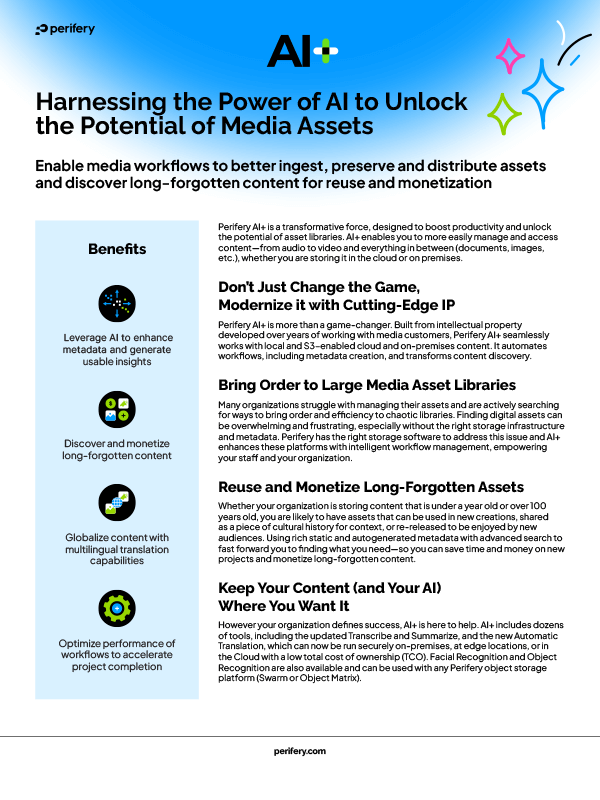
Summary:
Broadcasters face three key challenges in managing storage workflows:
- Content and metadata jails: Diverse workflows and tech stacks lead to isolated storage pools, complicating content sharing and retrieval. Implementing a hybrid solution can enhance universal access and reduce costs.
- Limitations of LTO: LTO isn't sufficient for instant content access during outages. Broadcasters need modern Business Continuity Plans (BCPs) with object-based storage for better access and analysis capabilities.
- Cloud Considerations: Public cloud alone isn't ideal for active archives due to unpredictable costs and risks. A media-focused object storage platform offers better control, on-demand access, and enhanced security.
Perifery provides smart storage solutions tailored to media companies, focusing on content re-use, efficient retrieval, cost control, compliance, and future-proofing against outdated formats. We're ready to help broadcasters enhance their storage strategies. Let’s connect.
Having worked with leading broadcasters for more than two decades, we have identified several common storage workflow challenges faced within the media and entertainment sector. Having access to content from anywhere at any time is crucial for businesses to thrive, so addressing these issues with the right technology and vendors is essential.
In this blog, we take a closer look at the 3 key challenges broadcasters face and outline how to overcome them.
Challenge 1: Content and metadata jails
Broadcasters typically rely on diverse workflows and technology stacks from various vendors to solve their business challenges. Many have seamlessly integrated Avid technologies, such as Avid Media Central PAM or MAM into their ecosystems to manage predominantly Avid-based content. However, these organizations are also likely to rely on other industry-leading platforms to achieve their strategic goals.
The consequence? Workflows become scattered across various storage pools – portable, production, nearline, or archive – creating isolated islands that hinder the seamless sharing of content across teams and workflows.
Historically, archiving content to LTO using different platforms results in content that is either non-portable or labelled as ‘dark media’, making access and utilization difficult. Additionally, metadata - the crucial companion to content - is often confined within these storage islands, complicating content retrieval and sharing even further.
The solution? Implement a hybrid cloud storage platform.
This transformative approach ensures universal access to assets from all workflows, breaking down the barriers of isolation. A hybrid solution can reduce operational costs, boost collaboration, and enhance creativity. Content becomes accessible from anywhere, anytime, empowering content producers to efficiently find and use archived content.
Challenge 2: The limitations of LTO for Business Continuity
The stark reality is that many broadcasters are not sufficiently prepared for local, regional, or global outages. Although LTO may be fine for Disaster Recovery, it doesn’t provide instant access to content should the worst occur.
Broadcasters need to modernize and future-proof their Business Continuity Plans (BCPs) to ensure staff can access archive content from anywhere, at any time. This shift requires forward-thinking, and a move from LTO to object-based storage – whether on-prem, cloud, or a mix – makes most strategic sense.
Key point: If you frequently access content from an archive or perform analysis on the data you own, then LTO is not the optimal solution. In the broadcast industry where news and sports broadcasters need instant access to decades worth of archived content, the only platform that offers full unfettered access, with little or no operational resource to support, needs to be based on a media-centric object storage platform.
3. Cloud considerations
Using the public cloud for archive copies is good practice, but it's not ideal as the sole source for active archives. And it’s always important to remember that public cloud isn’t the only form of cloud! While it may satisfy some deep archive goals, it comes with challenges that may offset your strategic goals. Costs and performance can be unpredictable, and retrieving your own data can incur high fees. It can also lead to risks related to data sovereignty, security, and compliance.
To mitigate these issues, broadcasters should consider a storage solution that offers more control, provides on-demand access, and enhances security, without holding your content to ransom.
A media-focused platform is the obvious solution here. Integrating seamlessly with content driven workflows, media–focused object storage seamlessly integrates, provides robust metadata management, and ensures quick, efficient access to media files.
The Perifery Approach
At Perifery, we understand the unique archiving challenges faced by media and broadcasting companies. Our smart storage solutions were built for the media industry and are designed to address your key concerns:
- Re-use & Monetization: Effortlessly repurpose existing content and unlocking new revenue streams
- Content Management & Retrieval: Search and retrieve assets with ease, from anywhere, at any time
- Costs: Stay in control by identifying and moving less frequently accessed content to cost-effective archives
- Compliance: Ensure compliance with legal requirements and industry standards - safeguard your content and your reputation!
- Proprietary and Obsolete Formats: Overcome challenges of working with outdated formats and future-proof your media assets
If you're considering a tech refresh, we're here to help! We're already working with leading global broadcasters, and we'd love to share our storage technology and expertise with you too.
